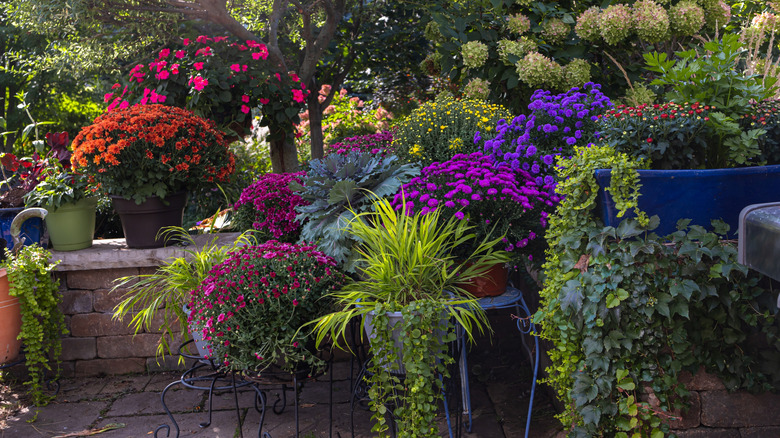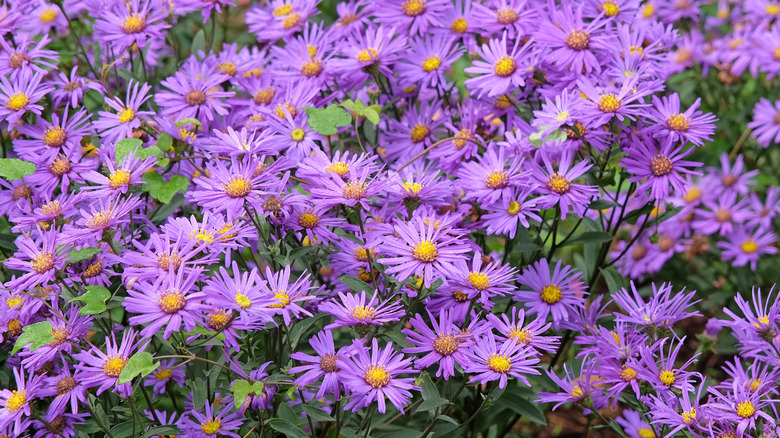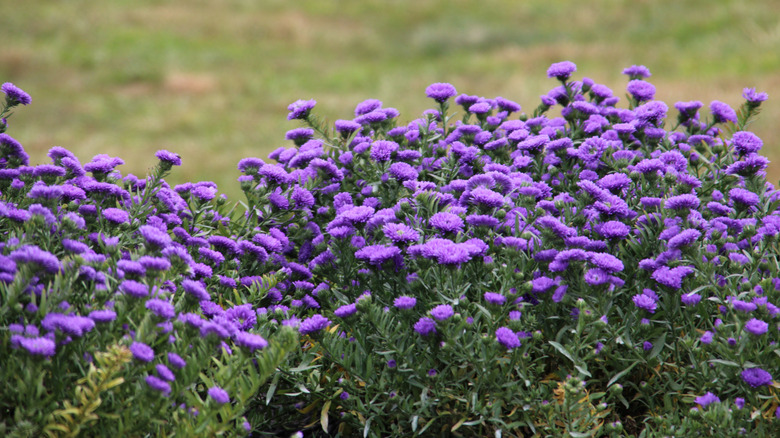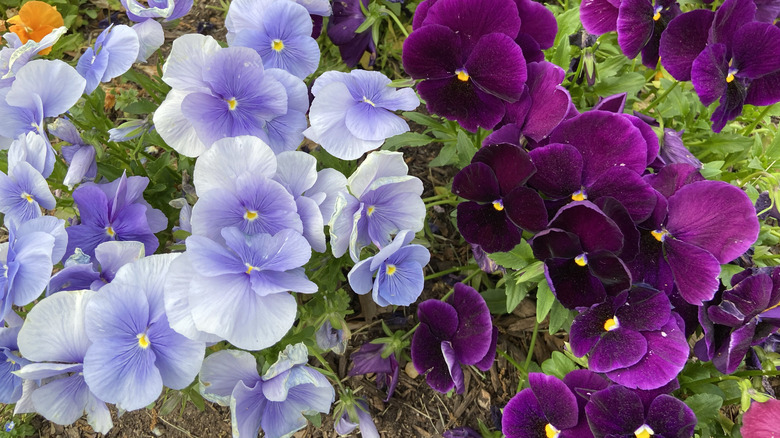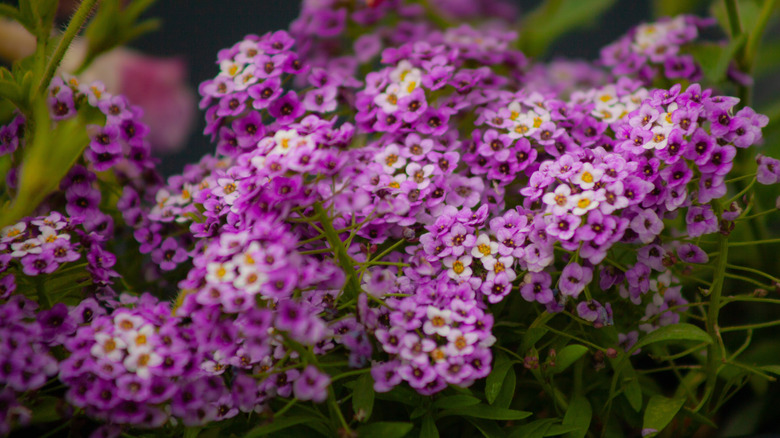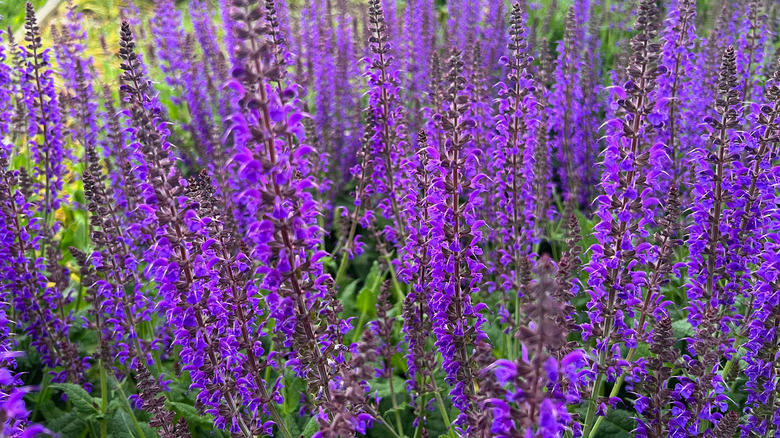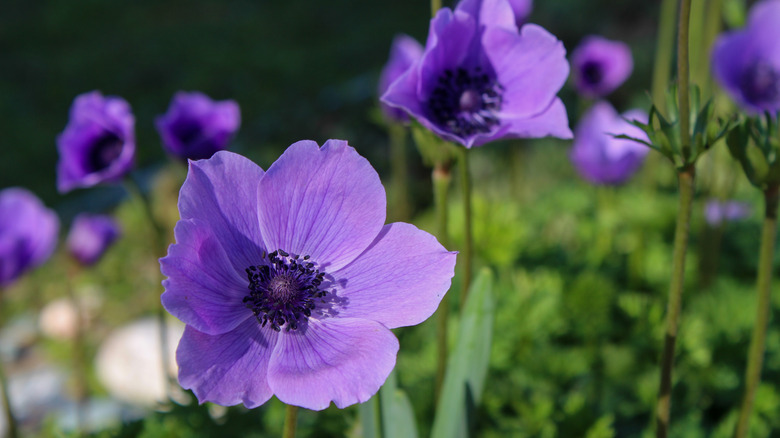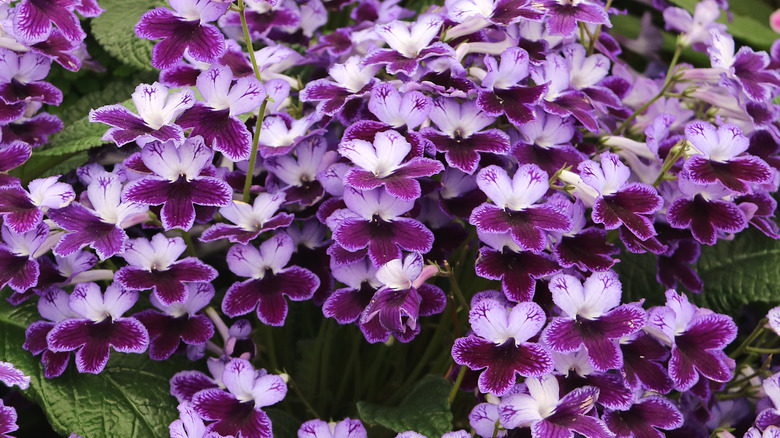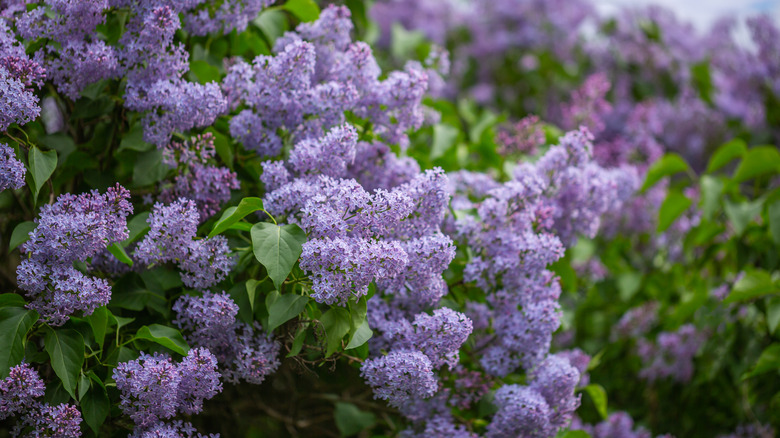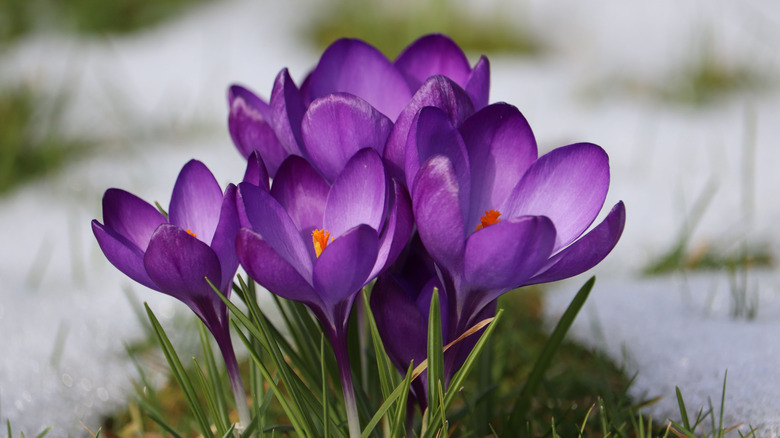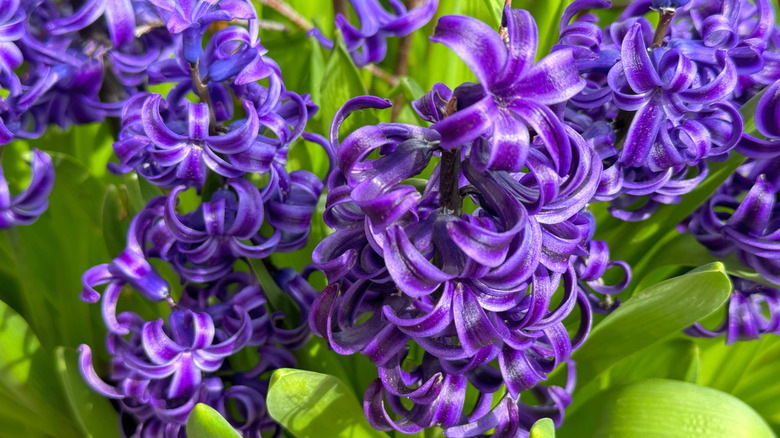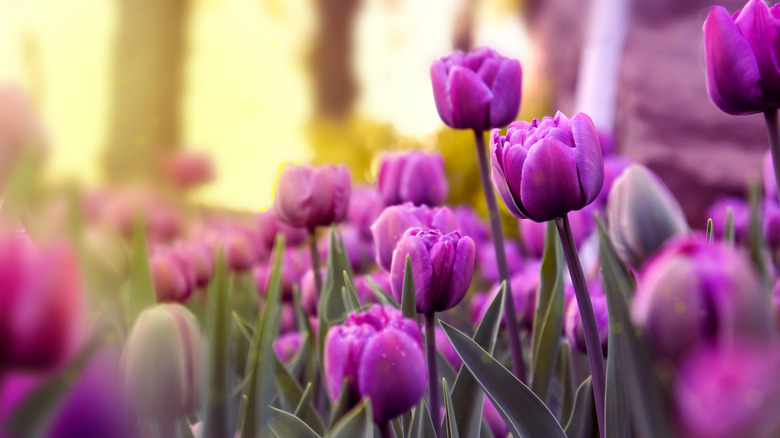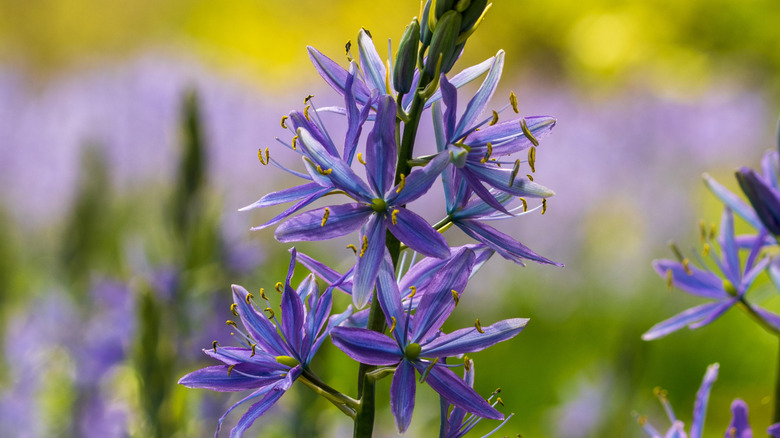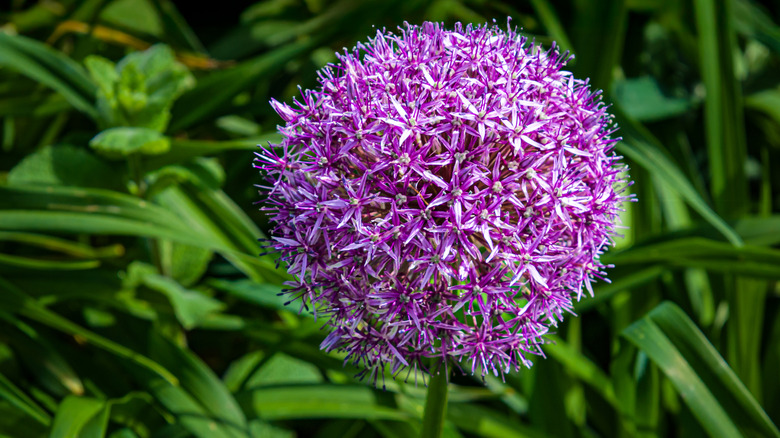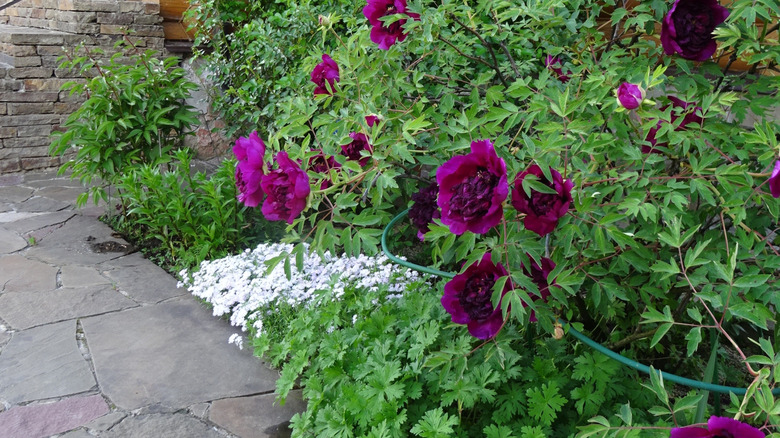14 Gorgeous Purple Flowers You Should Be Planting In October
Like watching the credits roll by at the end of a favorite movie, fall to-do lists for the garden contain lots of tasks centered on closing up the beds for the year. Harvesting, trimming back dead foliage, and giving tools a final cleaning may be at the top of your checklist. Instead of focusing entirely on the end of plant growth for the year, some October flower planting helps stave off the doldrums we gardeners sink into at the sight of bare earth in hibernating beds. It's just the right time to tuck in some flowers to enjoy for Halloween or over the winter, or to bury seeds and bulbs that dazzle in spring.
Purple flowers have been associated with romance, success, and admiration across cultures; from pale violet to electric plum and everything in between, there is a sizable number of blooms in this color family that can go into the ground in October. For beds brimming with purple blossoms in nearly any month, look to Chrysanthemums and asters for instant gratification, pansies to brighten bleak winter landscapes, and plenty of spring bloomers, such as hyacinths and crocuses, to herald the growing season.
Purple asters
Purple asters (Symphyotrichum patens) are some of the last wild blooms you'll see along roadsides and hiking paths in the fall. These sunny-centered toughies can stand the cold of zone 4 all the way to 8. Asters are perennials that tolerate frost and eventually go dormant over the winter. Pick up some potted purple asters from a nursery to enliven your landscape, or scatter seeds outdoors for overwintering. Asters like full to part sun and need moist, well-draining soil to thrive.
Mums
A fall landscape without mums (Chrysanthemum x morifolium) is definitely missing something. When planting these autumnal staples in mid-fall, it's smart to take a few steps to keep mums alive for more than one season. If you're opting to plant them in the ground, October may be too late for their roots to set up shop for winter survival. In areas where frosts are at least 6 weeks away, plant them in sunny spots with well-draining soil. In zones 2 to 5 or where frost is imminent, follow the same guidelines for potted mums that you'll bring inside for overwintering.
Pansies
Pansies (Viola x wittrockiana) are so misunderstood, their name is equated with weakness. This couldn't be farther from the truth. Winter gardens spangled with delicate-looking pansies are proof of their fortitude. Pansies can grow as perennials in zones 3 to 8, and they prefer chillier times of the year. They are frost-hardy and can handle a bit of snow, too. Save trouble by purchasing them from the nursery, since October is too late to start them from seed outdoors. Tuck some pansies in shades of purple into spots with full to part sun for a dose of happiness in winter.
Sweet alyssum
Sweet alyssum (Lobularia maritima) is a low-growing plant sporting bundles of tiny flowers that come in white, pink, and gradients of purple. This deceptively dainty-looking plant has a yen for the cool of spring and fall rather than sweltering summer heat, but it's not frost hardy. (It's a perennial in zones 8 to 11.) If a frost is still weeks away, unpack a few plants from the nursery to brighten flower beds with full to part sun or pots to bring indoors when the weather turns.
Salvia
Spiky, tall, and striking, Salvia is a durable flower with several varieties well-suited for growing in the fall. In general, salvia is hardy in zones 5 to 10, but Peruvian sage (Salvia discolor), hybrid sage (S. greggii), and autumn sage (S. x superba) bloom in purple and make good perennials with the right care in appropriate zones. Salvias of all types prosper in spots with full to part sun and well-draining soil. Research your favorite species before planting to ensure it isn't considered invasive where you live.
Anemones
Like pansies, Anemone species regale gardeners with a burst of floral delight while everything else is hibernating. There are more than 200 types of Anemone flowers that grow around the world, and ones like the Blakan anemone (Anemone blanda) and wood anemone (Anemone nemorosa) are ideal for October planting. Also known as windflowers, anemone bulbs take 3 to 4 months to emerge, slating their arrival in January or February. They are hardy in zones 4 to 9 and favor part to full sun and soil that's well-draining but kept moist.
Primroses
Primroses (Primula spp.) are hardy in zones 3 to 9, but they aren't fans of extreme heat or cold. So, if your area experiences mild weather this time of year, they can add some splashes of purple to your landscape. A few primroses that put on a show of purple in cooler weather are Siebold Primrose (Primula sieboldii) and the drumstick primrose (Primula denticulata). These perennials are among the earliest bloomers in late winter and early spring if your winters aren't too severe. Plant them in well-draining soil in part shade in hotter zones and full sun in cooler ones.
Lilacs
If you want to turn your garden into a bird paradise once the growing season is afoot, turn to lilacs (Syringa spp.). Enjoy October-planted lilacs by the time mid-spring and summer roll around in zones 3 to 7. These cool-climate favorites need a bit of time to spread out their roots for a successful springtime spectacle. Lilacs are hardy in a whopping range of zones, from 2 to 7. Set up your lilac plant in a spot with full sun and soil that won't retain too much moisture near the roots.
Crocus
Many spring flowers that appear while snow still lingers are as white as the frosty stuff we're sick of. The jewel-toned purple of Crocus buds are among the first early-risers who sport brilliant petals for our snow-weary eyes. Given that there are spring- and fall-blooming Crocus, October is too late to plant the fall-blooming variety. Get some spring bloomers into the soil this month, and you may see their first signs in February. Crocuses are hardy in zones 3 to 8 and proliferate in part to full sun and sandy soil with good drainage.
Hyacinth
While these conical, fragrant flowers come in other colors as well, purple hyacinths (Hyacinthus spp.) flaunt deep indigo blossoms that are as much a treat for the eyes as they are for the nose. Spend some time planting hyacinth bulbs this fall once the first frost has hit, but the soil hasn't yet frozen. Hyacinths are hardy in zones 3 to 9 and depend on a long period of cold in order to flower once spring arrives. Plant hyacinth bulbs in full to part sun and fertile soil that doesn't stay consistently wet.
Tulips
Not too hot or too cold, October serves up the perfect weather for tulip (Tulipa spp.) planting in many places. You should plant tulip bulbs about six to eight weeks before your first frost, so although they're hardy in zones 3 to 8, the planting window may have already closed for you. Bury tulip bulbs in sunny spots in lower zones, but scout out one with a bit of shade for gardens in zones 7 and 8. Tulips need well-draining soil to thrive.
Camassias
Relatively unknown Camassia is a purple flower similar in shape to a lupine with thin-petalled starbursts of flowers. Growing up to 4 feet tall, this stunner needs a period of cold to reach its peak height. Settle Camassia tubers in the soil in October in order for it to pop up in spring. This native of the Pacific Northwest is pretty easy-going; it doesn't mind boggier soil, and it will flourish in full sun or part shade in zones 4 to 8.
Alliums
The ornamental onions (Allium aflatunense) that we call alliums don't look as though their fine stems should be able to keep such outsized orbs vertical. This whimsical purple plant is among the last of the bulb-grown flowers to shoot up in the spring. Alliums are hardy in zones 4 to 9 and do best in a sunny to partly shaded spot with good drainage. However, they are a pretty low-maintenance addition to a garden. As long as you bury the bulbs between 6 to 8 inches deep, alliums will be content with little more than occasional water.
Peonies
Spring or summer-blooming peonies (Paeonia spp.) deserve some autumnal attention. These beauties are known for their blooms in an array of pinks, but purple peonies show off a range of hues nearly as varied as their pink siblings. Although peonies don't give instant gratification, planting them (or dividing crowded ones) in October gives the roots ample time to get comfortable before a deep freeze. Peonies are hardy in zones 3 to 8 and love full to part sun and rich soil.
